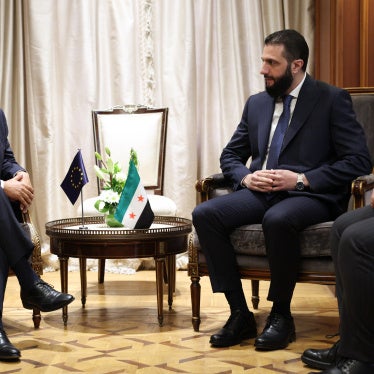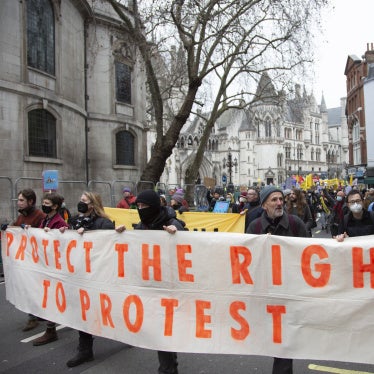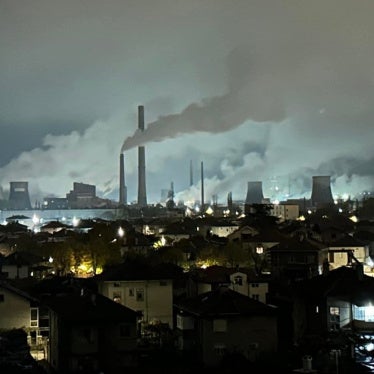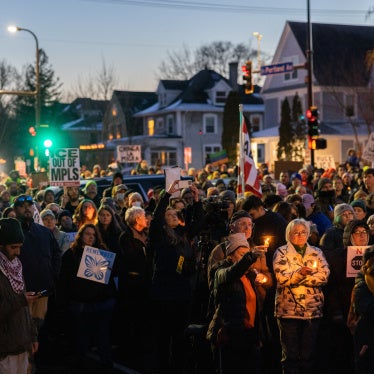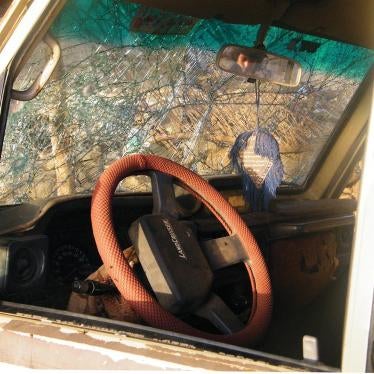(Simferopol) – Self-defense units and paramilitary forces in Crimea are abducting, attacking, and harassing activists and journalists.
These forces operate outside of the law, without insignia, without a clear command structure, and with complete impunity. Local authorities in Crimea have a responsibility to ensure these forces cease their actions, disband, and disarm, Human Rights Watch said.
“Crimean authorities are allowing illegal and unidentified armed units to run the show in the peninsula, and to commit crimes that go uninvestigated and unpunished, as if there is a legal vacuum,” said Rachel Denber, deputy Europe and Central Asia director at Human Rights Watch. “Far from it. The local authorities have clear legal obligations to provide protection and security to those in their jurisdiction.”
Human Rights Watch documented the involvement of self-defense units in the abductions of at least six activists from the Euromaidan movement, which organized the months of protests in Kiev that led to President Viktor Yanukovich’s ouster. These units have also attacked and harassed numerous local and foreign journalists.
Local and international media freedom groups have also documented dozens of attacks against reporters by self-defense groups across Crimea. Ukrainian human rights groups have reported that the units have also been involved in violently dispersing demonstrations, unlawfully searching people and vehicles, especially at the Crimea’s administrative borders, and harassing ordinary citizens.
Self-defense units started actively operating throughout Crimea at the end of February 2014. Their “commander,” Pavel Sheremet, his official status unclear, said at a news conference on March 4 that the units consist of former policemen, former army officers, Afghan war veterans, and others. Sheremet emphasized that the units do not have the right to conduct searches or arrests, and should operate jointly with the police.
The head of the Crimean Council of Ministers, Sergei Aksenov, said that as of March 4, 11,000 men have signed up as members of self-defense units, and that they are armed with shields, sticks, and “lawfully registered firearms.” Aksenov said that the units will be necessary before and during the referendum on the status of Crimea, scheduled for March 16, and until the situation in Ukraine “stabilizes.” He denied widespread allegations that Russian security services were among the units.
According to statements by officials in Crimea, these forces have “taken under control” all military installations, law enforcement agencies, and “strategic objects.”
However, Human Rights Watch observations on the ground in Crimea and interviews with people who had – or were witnesses to – interactions with self-defense units, suggest that these units operate outside any legal framework. Some wear camouflage clothes without insignia, others are in civilian clothes. Many wear armbands that symbolize loyalty to Russia with the colors of the Russian flag, or the black and orange St. George flag, the symbol of the highest Russian military honor. Units patrolling the streets are usually unarmed and do not wear masks, while those manning checkpoints, or other strategic locations, wear black balaclavas and carry automatic weapons, including AK-47s.
Ukrainian law allows for the “participation of citizens in maintaining law and order,” including the creation of self-defense units, but specifies that they are allowed to operate only jointly with regular law enforcement agencies, under clearly identified circumstances, and never with the use of firearms.
Human Rights Watch found that local police appear to have no coordination with or control over the units. In several cases documented below, witnesses and victims of abuses told Human Rights Watch that the police either were not present during the operations conducted by self-defense units, merely stood by, or explicitly refused to intervene, saying that they had no authority over these units.
Based on accounts by witnesses, as well as multiple professional and amateur videos posted on YouTube, the self-defense units are often accompanied by or operate together with Cossacks, as well as large groups of fully uniformed masked men without insignia, widely believed by the locals to be members of Russian armed or special forces. On at least one occasion reported to Human Rights Watch, a member of a self-defense unit admitted to belonging to Russian security forces.
A Ukrainian commander of one of the Ukraine military bases in Simferopol told Human Rights Watch that, as armed men in camouflage without insignia were taking over the base, the Ukrainian officers tried to negotiate with them, stating that Crimea was part of the Ukrainian territory, where Ukrainian laws applied. The commander said that one of the paramilitaries then yelled, “I don’t care about Ukrainian laws; I am an officer of the Russian Federation!”
Human Rights Watch is concerned that the presence in the streets and public buildings of armed men in military uniform, as well as self-defense patrols who are not members of regular law enforcement or security forces, pose a threat to the people’s liberty and security in Crimea.
The authorities in Crimea should immediately disarm and disband all units operating outside of the law, protect people from their illegal actions, and ensure that all law enforcement activities are carried out by the police, Human Rights Watch said. Authorities should ensure that any self-defense units that are created operate in accordance with the law and that the public is aware of the units’ chain of command structure and accountability mechanisms.
The authorities should also open investigations into crimes and human rights abuses allegedly committed by members of self-defense units and hold them to account. Those detained or “disappeared” by the units or paramilitaries should be immediately released, and journalists should be allowed to carry out their work without intimidation and harassment.
Under human rights law, including in particular the European Convention on Human Rights, which is binding on authorities throughout Ukraine, the authorities have an obligation to take appropriate steps to safeguard the lives and security of everyone within their jurisdiction. This obligation entails a duty to enforce an appropriate legal framework to deter the offenses against the person, in particular those that would lead to violations of liberty or security, or cause serious injury or loss of life. Permitting unregulated forces to carry out abusive security operations violates that obligation and basic respect for human rights.
“Crimean authorities have allowed the so-called self-defense units to have free rein in the lead-up to the referendum, and so far these units have focused on silencing critical voices and controlling information,” Denber said. “A campaign of threats, harassment, attacks, and even ‘disappearances,’ against activists seems to have no limits.”
“Disappearances” of Euromaidan activists
Andriy Schekun and Anatoly Kovalsky
At about 9:30 a.m. on March 9, Euromaidan activists Anatoly Kovalsky and Andriy Schekun went to the Simferopol train station to pick up a parcel from Kiev that contained Ukrainian flags, printed materials, and other items for an anti-war protest in Simferopol planned for that afternoon, Schekun’s wife told Human Rights Watch.
Witnesses at the train station later told the men’s lawyer and Schekun’s wife that Kovalsky stayed at the train station while Schekun went inside the train car to pick up the parcel. Several men in camouflage, some with red “self-defense” armbands, stormed into the train car, pulled Schekun outside, and surrounded Schekun and Kovalsky, who was waiting for him on the platform. The men then searched activists, pushing and hitting them, and led them away on foot.
One of the men’s lawyers told Human Rights Watch that while being led away, Schekun made a quick phone call saying he and Kovalsky were being taken away by unknown men. After that, both activists’ phones stopped working. The lawyer said:
Police at the train station could not get their story straight. First, a police officer told other activists who came to make inquiries that they had not detained anyone. Later, another police officer said that Schekun and Kovalsky had been in police custody but then representatives of the Crimean pro-Russian political party, “Russian Unity,” took them away from the police station.
The police officer later gave the same information to the Crimean TV station ATR, but when another journalist, from the Espreso TV station, contacted him, said that he had never heard of the two men.
There is no question why they were targeted. Both men are well-known activists, who organized local Euromaidan protests in Simferopol from the very beginning. They had received anonymous threats before.
On March 9, Kovalsky’s son filed a police report about the “disappearance” of both activists. According to the lawyer, the police investigation is ongoing. On March 10, at the lawyer’s request, the European Court of Human Rights sent an urgent communication to the Ukrainian authorities requesting information on the two men’s whereabouts.
On March 11, the head of the Crimean Council of Ministers, Sergei Aksenov, said publicly that Schekun and Kovalsky had been detained by Crimean “special forces” for their alleged involvement in “subversive activities” and will remain in custody until the referendum. He did not, however, reveal the men’s whereabouts.
Myhailo Vdovchenko
On March 11, Myhailo Vdovchenko, a resident of Simferopol who posted pro-Ukrainian messages on his Facebook page, participated in a peaceful pro-Ukrainian demonstration in Crimea in the city, his cousin told Human Rights Watch.
He never returned home from the protest and his relatives were unable to reach him by phone.
The next day, Vdovchenko’s cousin filed a police report about his “disappearance,” and posted messages both online and around the city, seeking witnesses. A witness who responded to the message told Vdovchenko’s cousin that at about 3:30 p.m. on March 11, she saw three men in civilian clothing stop Vdovchenko, who was carrying a Ukrainian flag. The men then led Vdovchenko down the street with his hands tied behind his back. According to the cousin, the witness also said that she saw the men beating and pushing Vdovchenko when he tried to break free:
Today [March 14] I went to the police, and the officer in charge of the investigation said that Myhailo and several other missing Euromaidan activists were being held at the regional conscription office in Simferopol.
He said the office was occupied by unknown military forces, and there was nothing the police could do about it. He just said I would just have to wait until the referendum was over, and hope that Myhailo would be released afterward.
The family has not received any official confirmation about Vdovchenko’s fate and whereabouts.
Alexei Grytsenko, Natalia Lukianchenko, and Serhiy Suprun
On March 14, several Euromaidan activists posted in their blogs that Grytsenko, Lukianchenko and Suprun, three activists of AutoMaidan, a part of the Euromaidan protest movement that organizes car rallies and patrols to protect protesters, were missing.
The bloggers wrote that local activists last saw Grytsenko, Lukianchenko, and Suprun – who, by that time, had been in Crimea for a week and a half – at about 11:30 pm on March 13 near a shopping center in Simferopol. The report said that one of the activists later made a call to a friend, saying that three cars were following their own vehicle. The activists have not been heard from since.
A local Euromaidan activist told Human Rights Watch that activists were able to track the signals from the three activists’ cell phones to the regional conscription office in Simferopol. In the afternoon of March 14, a number of journalists went to the conscription office asking about the fate of the missing activists but, according to one of the journalists, the men guarding the conscription office building denied having the activists in custody.
Attacks and harassment of journalists
Jacomo Liverani, an Italian freelance photographer, told Human Rights Watch that on March 13 he arrived at the town of Bakhchisarai, 35 kilometers southwest of Simferopol. He took photos around the town, without approaching any military installations, and as he was heading back to the bus station at about 5 p.m., a group of five men in civilian clothes approached him. They wore St. George armbands and were armed with knives:
They surrounded me, said they were self-defense, and demanded my documents. I showed them my press ID, then one of them made a phone call, and a few minutes later a civilian car arrived. They grabbed me and pushed me inside the car, and took me in the direction of the bus station. They took me inside a house, and there were some more self-defense men inside.
They put a knife to my throat, and forced me to hand over my documents, including my passport, my laptop, and camera. I called a friend and asked him to contact the Italian embassy in Kiev. When they called me back, I passed the phone to one of the self-defense guys, but he swore at the embassy official and told him “It’s not Ukraine here, it’s Crimea, Russia.”
Liverani said that the self-defense men then copied the files from his camera and laptop, including contacts, and five hours later released him.
Anton Goloborod’ko, a journalist with the Ukrainian online newspaper Gazeta po Ukrainski, told Human Rights Watch that on March 7 at 11 a.m. he arrived with a group of journalists at the regional military conscription office in Simferopol because they had received reports of a shootout there. Outside of the office they saw a large group of men in civilian clothes, without insignia, masked, and armed with AK-47s:
The men asked us to step aside. We moved away and went to the road police office nearby. We asked the policemen there what was going on, but they said they didn’t know and that the police were staying “out of politics.”
We went back and stopped about 50 to 70 meters away, waiting. A man in camouflage uniform, masked, and with an automatic weapon, approached us, and told us not to film. A few minutes later, a white minivan left the conscription office and drove toward our group.
Five or six men, all masked, some in camouflage and some in civilian clothes, jumped out, and ordered all cameramen and photographers hand over their equipment. When we refused, they started punching and kicking us, and forcibly took away the cameras. They took a memory card from my camera, and asked for my papers. I pointed at him my ID card which was hanging around my neck. He grabbed the string the ID was hanging on, and started strangling me with it, and then tore it off my neck, threw it in their car, and left.
Beloborod’ko said he did not approach the police about the incident, because he believed it was useless and the police were “too afraid to perform their professional duties.”
A female foreign journalist told Human Rights Watch that around noon on March 12, she went with her photographer to the Chongar checkpoint, in the northern part of Crimea, near the administrative border. As they approached the checkpoint, they saw a group of men in randomly assembled uniforms (some had camouflage pants and some had jackets), some wearing black balaclavas, and fully armed with AK-47s, knives, and pistols. The journalist, who asked not to be named to protect her security, said that the men had armbands with the colors of Russian flag but no insignia. There were also some Cossacks, in their traditional hats and uniforms, in the group:
The men were taking photos of themselves, and we also asked permission to take their photo. One of them seemed to have nodded “yes,” but when the photographer pointed her camera at them, a huge guy from the group jumped on her, grabbed her camera, and walked away with it. He kept trying to get the memory card out, and to delete the photos, but didn’t succeed.
We asked them who they were, but they were silent, and just pulled their balaclavas up to cover the slit that showed their eyes.
There were also soldiers at the checkpoint, wearing proper uniforms, but also no insignia. They spoke Russian and wore Russian military uniforms. They had more serious weapons, however: RPGs and sniper rifles. They just walked away while we were trying to negotiate with the self-defense unit.
The journalist said that the self-defense unit at the checkpoint eventually made them delete the photos from the camera and then let them go.
Jan Husar, a freelance journalist from Slovakia, told Human Rights Watch that at about 2 p.m. on March 12, he came to the civilian airport in Simferopol and tried to take pictures of the surroundings. He said that as soon as he took his camera out, a civilian car stopped next to him, and two men, wearing black clothes without insignia and armed with pistols, jumped out of the car:
The two asked me for my documents, and I asked for theirs. They showed me their IDs – I could not see what exactly was written there, but saw that it was in Russian, I can tell the difference between Russian and Ukrainian language. Then, a group of another 15 men, in civilian clothes with red and St. George armbands, approached me, and pulled me to a nearby forest, screaming at me.
They took away my camera bag. Sometime later, an older man appeared, and things calmed down a bit. They let me go, but kept the memory cards from my camera.
